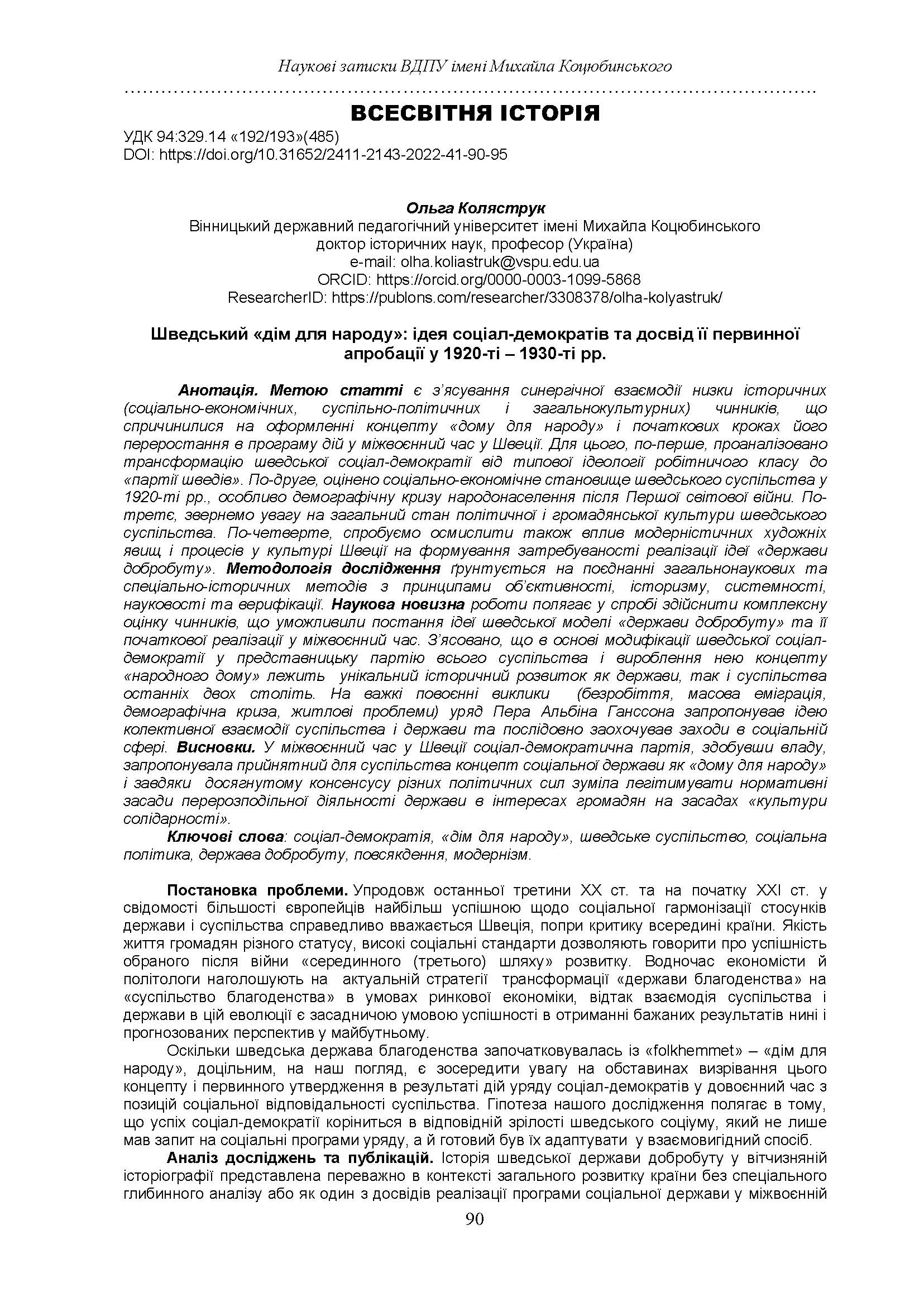Abstract
The purpose of the article is to clarify the synergistic interaction of a number of historical (socio-economic, socio-political and general cultural) factors that led to the design of the "home for the people" concept and the initial steps of its transformation into a program of actions in the interwar period in Sweden. To do this, firstly, the transformation of Swedish social democracy from the typical ideology of the working class to the "party of the Swedes" was analyzed. Secondly, the socio-economic situation of Swedish society in the 1920s was evaluated, especially the demographic crisis of the population after the World War I. Thirdly, let's pay attention to the general state of the political and civic culture of Swedish society. Fourth, we will also try to understand the impact of modernist artistic phenomena and processes in the culture of Sweden on the formation of demand for the implementation of the idea of a "welfare state". The research methodology is based on a combination of general scientific and special historical methods with the principles of objectivity, historicism, systematicity, scientificity and verification. The scientific novelty of the work consists in an attempt to carry out a comprehensive assessment of the factors that made possible the emergence of the idea of the Swedish model of the "welfare state" and its initial implementation in the interwar period. It has been found that the basis of the modification of the Swedish social democracy into a representative party of the whole society and its development of the concept of "people's house" lies in the unique historical development of both the state and society of the last two centuries. In response to difficult post-war challenges (unemployment, mass emigration, demographic crisis, housing problems), the government of Per Albin Hansson proposed the idea of collective interaction between society and the state and consistently encouraged measures in the social sphere. Conclusions. In the interwar period in Sweden, the social democratic party, having gained power, proposed a socially acceptable concept of the welfare state as a "home for the people" and, thanks to the consensus reached by various political forces, managed to legitimize the normative principles of redistributive activity of the state in the interests of citizens on the basis "cultures of solidarity".
References
Андерсен, Єнс (2021) Цей день і є життям. Біографія Астрід Ліндгрен / пер. з дан. К. : Наш Формат. 320 с.
Квас, О. (2011). «Століття дитини» та принципи нової педагогіки Еленн Кей Педагогічні науки. Зб. наук. пр. Дрогобич. Вип. 97. 89–97.
Коструба, В. В. (2010) Шведська модель соціально-правової держави (історико-теоретичний аналіз): автореф. дис. … канд. юрид. наук : 12.00.01 / Київ. нац. ун-т ім. Т. Шевченка. К. 18 с. С. 7.
Михайленко, Е. (2010) Карл Ларссон і його скандинавський інтер’єр Скандинавський стиль. URL: http://scandistyle.ru/karl-larsson-i-skandinavskij-interer/
Стігліц, Джозеф (2021). Держава загального добробуту у 21-му столітті. GROWFORD Institute 15.03. URL: https://sg-sofia.com.ua/derzava-zagalnogo-dobrobutu-u-xx1-stolit
Götz, Norbert (2004) The Modern Home Sweet Home The Swedish Success Story? Kurt Almqvist and Kay Glans (eds). Stockholm : Axel and Margaret Ax: son Johnson Foundation, 97–107, 300–302.
Hjartarson, Benedikt (2019). A Cultural History of the Avant-Garde in the Nordic Countries 1925–1950. Vol. 36. Leiden – Boston. 968 рр.
Lindvall, Johannes (2004). The Politics of purpose. Swedish macroeconomic policy after the golden age. Department of political science Göteborg University. 208 рр.
Odhnoff, C. (2008). Folkhemmet byggde dagens moderater, Dagens Nyheter, 07.06.
Rudberg, Eva (1999) The Stockholm Exhibition 1930: Modernism's Breakthrough in Swedish Architecture. Stockholmia, 238 рр.
World Happiness Report (2022). URL: https://happiness-report.s3.amazonaws.com/2022/WHR+22.pdf

This work is licensed under a Creative Commons Attribution 4.0 International License.
Copyright (c) 2022 Ольга Коляструк





